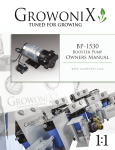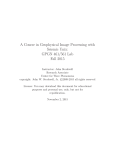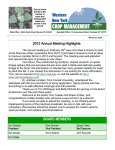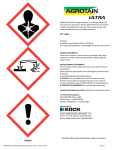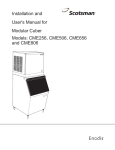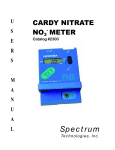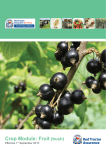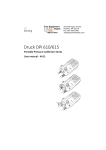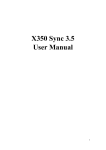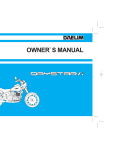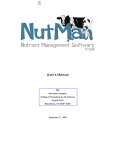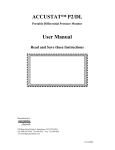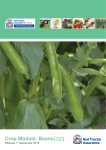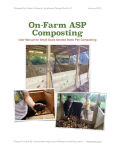Download User`s Manual - Cornell University Nutrient Management Spear
Transcript
MANURE VALUE, COST AND TIME MANAGEMENT CALCULATOR USER’S MANUAL Caroline Rasmussen, Margaret Dunn, Patty Ristow, Quirine Ketterings, Tim Shepherd, Karl Czymmek FEBRUARY 2011 Nutrient Management Spear Program Collaboration among the Cornell University Department of Animal Science, PRODAIRY and Cornell Cooperative Extension http://nmsp.cals.cornell.edu Contents 1. Introduction ................................................................................................................................. 1 Items Needed to Fill Out Sheets ................................................................................................. 2 2. What is the break-even hauling distance for my manure? ......................................................... 3 Fertilizer Replacement Value Sheet 3. What are the operating and ownership costs for my manure machinery? ............................... 23 Whole Farm Manure Cost Sheet 4. What is the value (fertilizer replacement) and cost of exporting manure? ............................... 30 Export Sheet 5. How much time (machinery and labor) will it take to spread manure? .................................... 33 Time Sheet Correct citation: Rasmussen, C., M. Dunn, P.L. Ristow, Q.M. Ketterings T. Shepherd, K. Czymmek (2010) Manure Value, Cost and Time Management Calculator; User’s Manual. Department of Animal Science. Cornell University, Ithaca NY. 38 pages. Downloadable from: http://nmsp.cals.cornell.edu/projects/curriculum.html. For more information: Contact Quirine Ketterings at the Nutrient Management Spear Program, Department of Animal Science, Cornell University, 323 Morrison Hall, Ithaca NY 14583, or e-mail: [email protected]. 1. Introduction This calculator was designed to estimate manure spreading costs in relation to the value of manure nitrogen (N), phosphorus (P) and potassium (K) using different manure spreading strategies at the field and whole farm levels. By changing the type or cost of equipment, labor inputs, manure nutrient densities and application methods, fuel costs, and fertilizer costs, different scenarios can be created to evaluate different manure allocation options. The calculator can provide answers and analysis for several questions: 1. What is the fertilizer equivalent value of a manure application? 2. What is the break-even hauling distance for hauling my manure? 3. What are the operating and ownership costs for my manure machinery? 4. What is the value (in terms of fertilizer replacement) and cost of exporting manure? 5. How much time (clock hours as well as machinery and labor) will it take to spread manure? Upon opening the calculator, buttons will be displayed with these questions. Clicking on a button will bring you to the appropriate input and results page. You can also navigate by clicking on the tabs at the bottom of the screen. From any screen, at the top right-hand corner of the page, there are two buttons that will take you to the User’s Manual for help, or to the Main Menu (the “Return” button). Entering the example data in the steps that are outlined in this user manual will provide the results shown in snapshots throughout the user manual. Warning: Feasibility and quality of the output of the calculator are dependent on the quality and reliability of the input data used; these input data are the responsibility of the person using the calculator. The equations in this calculator reflect our best effort to interpret a complex body of scientific research on nutrient crediting and economic assessment, and to translate this into practical management options. Implementation of manure management practices based on the output of the calculator does not assure compliance with any applicable law, rule, regulation or standard, or the achievement of particular discharge levels from agricultural land. Information Requirements Farm-specific data are required. To limit redundant data entries, we have attempted to organize the sheets so that the same information is only entered once. While each different sheet of the workbook deals with a different question above, many values from one sheet are transferred to another. Using the sheets in the order that they appear on the opening screen will ensure that all of the required information is entered. 1 Items Needed to Fill Out Sheets (1) Fertilizer Replacement Value Manure analysis (%, lb/gallon, or lb/ton of N, P2O5, and K2O). Crop requirements (lb/acre of N, P2O5, and K2O). Value of fertilizer ($/lb of N, P2O5, and K2O). Field size (acres). Application rates (gallons/acre or ton/acre). Spreader capacity (gallons or ton). Operating costs: fuel price, hourly labor costs. Fuel efficiencies: average equipment speed (miles/hour for hauling; acres/hour for application and incorporation), fuel consumption (gallons/hour). (2) Whole Farm Manure Cost Total manure to spread for the entire year (gallons or tons). Total acres on which manure is spread and/or incorporated. Total hours required to haul, spread, and incorporate manure. Capital costs: purchase and salvage values of equipment, lifespan, age, repair costs; % of capital cost used by the business, equipment insurance cost, value of insured equipment. Information Taken from Other Sheets Fuel efficiency (Fertilizer Replacement Value, Section (5)). (3) Export Field size (acres). Application rate (gallons/acre or ton/acre, same units as in Fertilizer Replacement Value). Distance from source (miles, one-way). Crop needs (lbs/acre of N, P2O5, and K2O). Information Taken from Other Sheets Manure analysis and density (Fertilizer Replacement Value, Section (1)). Fertilizer values and application cost (Fertilizer Replacement Value, Section (2)). Application units (Fertilizer Replacement Value, Section (4)). Spreader capacity (Fertilizer Replacement Value, Section (4)). Hauling speed (Fertilizer Replacement Value, Section (5)). Total gallons of manure to spread (Whole Farm Manure Costs). Total hours to spread manure (Whole Farm Manure Costs). Total per hour costs for spreading and incorporation (Whole Farm Manure Costs). Total equipment and machinery ownership costs (Whole Farm Manure Costs). (4) Time Total loads of manure hauled or spread. Time for each hauling trip (hours). Speed of spreaders (loads/hr). 2 2. What is the break-even hauling distance for my manure? Fertilizer Replacement Value Sheet Section (1): Manure Nutrient Content In this section white cells (boxes) are open for data entry and yellow cells (boxes) are calculated values. The yellow cells present results based on data entered into white cells. Yellow cells are locked and cannot be manipulated (Figure 1). Figure 1: data entry for section (1) of the calculator with example data. a. Animal Species: Animal species must be chosen from a pull down menu. Place the cursor in the data entry box and then click the down-pointing arrow that appears on the right; a list will be pulled down and an animal species can be chosen. This information is important for calculating expected N credits from organic N mineralization over three years following application. A decay or mineralization series is commonly used to estimate the rate of N availability from stable organic N. A decay series of 35, 12, and 5% is used to estimate the rate of decomposition of organic N in liquid (<18% dry matter) dairy manures in New York. This sequence of numbers means that 35% of the organic N is mineralized and potentially taken up by the growing crop during the year the manure was applied, 12% of the initial organic N application is mineralized and taken up during the second year, and 5% is mineralized and taken up in the third year. There is evidence that manure containing large amounts of bedding may mineralize at a slower rate than fresh manure. Therefore, the estimated availability of N during the year applied is reduced from 35 to 25% when the dry matter content of the manure exceeds 18%. These decay series and those for other animal manures are listed in Table 1. 3 Table 1: Decay series for stable organic N in manure by animal type. A “last year release rate” of 12% indicates that an estimated 12% of the organic N applied in the manure is expected to be utilized by the crop a year after application. Release rate for organic N in manure (%) Source Total Solids (%) Present Year “Decay_current” Last Year “Decay_lastyr” Two Years Ago “Decay_2yrs” Cows Cows Poultry Poultry Swine Swine Horses Horses Sheep Sheep <18 18 <18 18 <18 18 <18 18 <18 18 35 25 55 55 35 25 30 25 35 25 12 12 12 12 12 12 12 12 12 12 5 5 5 5 5 5 5 5 5 5 b. Units: Manure nutrient analysis can be presented in various units: percent, pounds per ton and pounds per 1000 gallons. Units must be selected from the pull down menu. Place the cursor in the data entry box and then click the down-pointing arrow that appears on the right; a list will be pulled down and a unit selection can be made. The units should match what is reported on the manure analysis from the laboratory. c. Ammonium-N: Ammonium-N or NH4-N should be entered in units listed beside the data entry box. Double check the manure analysis report and the spreadsheet to make sure the units are the same. If they are not the same, change the units by clicking on the data entry box labeled “Units”. d. Organic-N: Organic-N content should be entered in the same units as listed beside the data entry box. Double check the manure analysis report and the spreadsheet to make sure the units are the same. If they are not, change the units to be consistent with the manure analysis report clicking on the data entry box labeled “Units”. e. Total N: Total N is calculated as the sum of ammonium-N and organic-N. Data cannot be entered into this cell. f. P2O5: Phosphorus content (reported as P2O5 equivalent) should be entered in units listed beside the data entry box. Double check the manure analysis report and the spreadsheet to make sure the units are the same. If they are not, change the units to be consistent with the manure analysis report. Make sure that the value entered is in P2O5 equivalents, NOT the P content in the manure. If your manure analysis report only lists P, convert this value to P2O5 by multiplying by 2.29. g. K2O: Potassium content (reported as K2O equivalent) should be entered in units listed beside the data entry box. Double check between the manure analysis report and the spreadsheet to make sure the units are the same. If they are not, change the units to be consistent with the manure analysis report. Make sure that the value entered is in K2O 4 equivalents, NOT the K content of the manure. If your manure analysis report only lists K, convert to K2O by multiplying by 1.20. h. Total Solids: Total solids are reported as a percentage. If “total solids” is not reported but percent moisture is given, the total solid content can be determined by subtracting the percent moisture from 100. i. Density: Manure density is the mass per gallon usually reported in kg per liter (for comparison, the density of water is 1 kg/liter). Different manure sources on a farm can have different densities, which can impact the cost effectiveness of transporting nutrients to farm fields. If your report only lists kg/liter (kg/L), convert to lb/gallon by multiplying by 8.35. In our practice example (found in the companion spreadsheet “Manure Value Calculator User’s Manual”) we use manure from cattle with less than 18% solids and the manure nutrient content is listed in percents (instead of pounds per ton or pounds per 1000 gallons) Section (2): Fertilizer Costs a. Fertilizer Costs: To determine the fertilizer replacement value of manure, contact the fertilizer dealer to obtain component values. Component values can differ depending on the base materials used to obtain different mixes. Determine what fertilizer mix you would purchase if manure were not available and obtain the component value of that mix from your fertilizer sales representative. Figure 2: Section (2) of the calculator with example data.. b. Fertilizer Application Costs: Estimate what the fertilizer application costs would be if fertilizer were applied instead of manure. Include equipment, labor and fuel in this cost. If there is a custom fertilizer applicator in your area, they may have the best estimate of what the per-acre cost would be for a fertilizer application In our practice example we use a cost per unit of N, P2O5 and K2O as shown in figure 2 and a cost for the application of $10.00 per acre. The total cost to supply the crop will be calculated after section 3 is filled in. 5 Section (3): Crop Nutrient Needs The calculator calculates the fertilizer replacement value of the manure on (1) Total nutrients applied with manure and (2) Nutrient delivered by manure that are needed by the crop. Section 3 requires the nutrient needs of the crop to be defined (Figure 3). Figure 3: Section (3) of the calculator with example data. Manure nutrients (N, P2O5 and K2O) cannot be adjusted to fit crop needs like fertilizer. In order to credit only the nutrients in the manure needed by the crop, be sure to indicate what your crop nutrient needs are. Cornell nutrient guidelines can help determine crop nutrient needs based on soil type, field history and soil test levels. Cornell nutrient guidelines for N, P and K can be found at: http://nmsp.cals.cornell.edu/guidelines/nutrientguide.html. Section (4): Manure Application Figure 4: Data entry for section (4) of the calculator with example data. This section allows different combinations of applications rates and methods to be entered to achieve the desired nutrient credit for the current crop. Units: Two choices (tons or gallons) are presented and they must be selected from the pull down menu. Place the cursor in the data entry box and then click the down-pointing arrow that appears on the right; a list will be pulled down and unit selection can be made. a. Application Rate: Estimate an application rate that is appropriate for a particular field. This value can be manually entered or automatically calculated using the “Balance to …” buttons to the right. b. Application Method and Timing: Place the cursor in the data entry box and then click the down-pointing arrow that appears on the right; a list will be pulled down and a unit selection can be made. Application method can be changed in combination with application rate to deliver the desired amounts of nutrients. Choices are listed in Table 2. The main impact of application method and timing is on ammonium-N conservation. Injection or incorporation during the growing season helps conserve ammonium-N. Non-incorporation of manure or applying manure in the fall leads to loss of the ammonium-N in the manure. Surface applications without 6 incorporation will result in higher application costs due to the higher manure loading rates than would be needed to meet N needs when manure is incorporated. Such higher application rates will also lead to increases in soil test P and K over time. Table 2: Manure application methods and the impact on Ammonium-N credits Manure Application Method Injected as sidedress on row crops Spring incorporated within 1 day Spring Incorporated within 2 days Spring Incorporated within 3 days Spring Incorporated within 4 days Spring Incorporated within 5 days Topdressed or incorporated after 5 days Fall incorporated or injected Surface application on frozen or saturated ground % Ammonium-N Credited Lost 100 65 53 41 29 17 0 0 0 0 35 47 59 71 83 100 100 100 c. Spreader Capacity: Enter the actual capacity of the spreader given foaming reductions and reductions made to reduce spilling. Spreader capacity impacts the amount of trips the spreader or hauling trucks must make to a field to achieve a given manure application rate. The number of trips the spreader or hauling trucks makes to a field changes the cost per field. Make sure the spreader capacity is correct for the units and application method and timing entered. d. Nutrient Balance Check: The nutrient balance check will allow you to see quickly if the current combination of manure analysis and application rate, method and timing will allow you to meet crop requirements as entered in the Crop Requirement section. The nutrient credits are calculated and highlighted in yellow. The credited nutrients are calculated based on the manure analysis, application rate, timing, and method. Surplus nutrients (more nutrient supplied by manure than required by the crop) are displayed in black. Nutrient deficits (more nutrients required by the crop than supplied by manure) are displayed in red (Figure 5). Figure 5: The Nutrient Balance Check table indicates the difference between the N, P2O5 and K2O required and supplied by manure in red if more nutrients are required than supplied and in black if more nutrients are supplied than required. 7 Clicking on the buttons shown in figure 6 will automatically balance for N, P2O5 or K2O. The Application Rate entry will be updated to the level that will balance for the nutrient selected. Figure 6: These buttons, found on the Fertilizer Replacement Value sheet, will (1) calculate and enter the manure application rate equal to the crop nutrient needs; (2) display an ammonia conservation graph (Figure 7) and (3) display a graph comparing nutrients supplied by manure to crop nutrient requirements (Figure 8). Manure Application Method and Timing: Effect on Ammonium-Nitrogen Availability from Manure 100 95 100 90 85 % of Manure Ammonium-N Utilized by the Crop 80 75 70 65 60 65 55 50 53 45 40 35 41 30 25 29 20 15 17 10 5 0 0 Injected as Spring Spring Spring Spring Spring Topdressed or sidedress on row incorporated within incorporated within incorporated within incorporated within incorporated within incorporated af ter crops 1 day 2 days 3 days 4 days 5 days 5 days Manure Application Method and Timing Figure 7: A graphical representation of manure application method and ammonium-N conservation. 8 Manure Nutrient Credits and Crop Nutrient Requirements 400 350 Nutrients (lbs/acre) 300 250 200 150 ON future 100 NH4 50 ON current 0 Manure N Supplied Crop N Requirement Manure P2O5 Supplied Crop P2O5 Requirement Manure K2O Supplied Crop K2O Requirement Figure 8: Graphical representation of manure nutrients delivered to the field compared to crop needs. Loads to meet requirements: The number of loads required to meet the application rate for the specified field is calculated and displayed (Figure 9). Figure 9: The calculator will display the loads required to meet the nutrient application scenario entered in Section (4). Section (5) Manure Nutrient Values The manure value section shows the nutrient value and fertilizer equivalent dollar value of various forms of nutrients in manure. The different values correspond to different multi-year nutrient management techniques. a. Total Ammonium-N: This is the total amount of ammonium-N potentially available, as recorded on the manure analysis. In our example: Total ammonium-N (lbs/acre) = 62,250 lbs manure/acre*100% conservation*0.09% NH4 = 56 lbs N/acre 9 b. Ammonium-N Lost: The estimated amount of ammonium-N lost with different types of manure application methods and timing combinations is shown for educational purposes. This value is not used in any other calculation in the calculator. In our example, there is a calculated difference between the 100% potential NH4 credit of 100% and the credit associated with the manure application practice entered, “Spring Incorporated, 1 day”, 65% credit. Ammonium-N lost (lbs/acre) = Total ammonium-N – ammonium-N credit = 20 lbs N/acre c. Ammonium-N Credit: This value is calculated based on the manure analysis, rate, method and timing. Applying manure during the growing season and incorporating it increases the amount of ammonium-N that can be credited and decreases N losses. Ammonium-N availability coefficients used are listed in Table 2. Ammonium-N credit (lbs/acre) = 62,250 lbs manure/acre*65% conservation*0.09% NH4 = 36 lbs N/acre d. Current Year Organic-N Credit: The availability of Organic-N is based on mineralization rates that have been calibrated for corn in New York State. The mineralization estimates are based on the percent dry matter content of different manure sources. Expected availability percentages of the original manure are listed in Table 1. Current Year Organic N Credit (lbs/acre) is the portion of the organic N available to the crop in the application year. In the example, manure organic N composition is 0.29%. = 62,250 lbs manure/acre*35% current year mineralization*0.29% organic N in manure = 63 lbs organic N/acre in current year application e. Organic-N Credit in Future from Current Application: Nitrogen expected to be released in future years from the current application are calculated based NYS standard mineralization rates for corn (Table 1). These values are included in the Max Value and AsApplied Value estimates. In our example, future organic N from current application: = 62,250 lbs manure/acre*17% future years mineralization*0.29% organic N in manure = 31 lbs organic N/acre in future year’s application f. N Available from Current Application: This value is the sum of ammonium-N credit and current year organic-N credit, adjusted for losses with various application methods and timings. 10 In our example: = Ammonium-N credit + current year organic N credit = 36.4+63.2 lbs/acre = 99.6 (displayed as 100 lbs/acre) g. P2O5 from Current Application: This value is calculated based on manure analysis and application rate. All of the manure P2O5 is assumed to become available for plant uptake in the year of application. In our example, P2O5 (as needed) value: = 62,250 lbs manure/acre*0.19% P2O5 in manure = 118.28 lbs P2O5/acre h. K2O from Current Application: This value is calculated based on manure analysis and application rate. All of the manure K2O is assumed to become available for plant uptake in the year of application. In our example, K2O (as needed) value: = 62,250 lbs manure/acre * 0.23% K2O in manure = 143 lbs K2O/acre i. Total N Value: This is the product of the "N Available from Current Application" and the N fertilizer value listed in section (2): Fertilizer Costs. In our example, the N fertilizer value is $ 0.50/lb and the total N (as applied) value: = $ 0.50*(36.4+63.2) = $ 49.80/acre, $66.40/load and $ 0.01/gallon j. Total P2O5 Value: This is the product of the "P2O5 from Current Application" value and the P2O5 value listed in section (2): Fertilizer Costs. In our example, the P2O5 fertilizer value is $ 0.60/lb and the total P2O5 (as applied) value: = $ 0.60 * 118.28 = $ 70.97/acre, $ 94.62/load and $ 0.01/gallon k. Total K2O Value: This is the product of the "K2O from Current Application" value and the K2O value listed in section (2): Fertilizer Costs. In our example, the K2O fertilizer value is $ 0.70/lb and the total K2O (as applied) value: = $ 0.60*118.28 = $ 100.22/acre, 133.63/load and $0.01/gallon l. As-Applied Value: "As-Applied Value" is the fertilizer replacement value of manure discounting N lost through volatilization and excess Ammonium-N applied, while crediting future organic-N, P2O5 and K2O for current and future crops. This value can be realized 11 through current application methods, credited organic-N mineralization from the manure and annual soil testing plus the fertilizer application cost that was replaced. In our example the total as-applied value: = $ 49.80+$70.97+$100.22+10.00 = $ 230.99 per acre, $ 307.98 per load and $ 0.03 per gallon m. As Needed Value: "As Needed" is the fertilizer replacement value of manure when only current crop N, P2O5 and K2O needs are credited (no value is credited to nutrients added over the crop need). In our example, manure applications meet or exceed all crop nutrients, so the as needed value is the same as the product of the crop nutrient requirements and the nutrient value as detailed in Table 3. Table 3: Example as needed fertilizer replacement value of manure only credits the lesser amount of the current year crop nutrient requirement or the nutrients supplied by the current year manure application. Nutrient Lesser of *Value =Value Crop requirement Available from current year ($/lb) ($/acre) manure application (lbs/acre) (lbs/acre) N 100 99.6 $0.50 $ 49.80 P2O5 25 118 $0.60 $ 15.00 K2O 20 143 $0.70 $ 14.00 Application $ 10.00 Total Per acre $ 88.80 Per load $ 118.40 Per gallon $ 0.01 Section (6): Operating Costs and Fuel Efficiencies This section allows the user to define variable (fuel, labor) costs associated with different manure spreading strategies. Note that if application and incorporation are done simultaneously, values representative of the total spreading-incorporating activity should be entered once in only one of the provided fields. Both application and incorporation should be filled out only if the two practices are done at different times (see Figure 10). 12 Figure 10: In this example, manure application and incorporation are done consecutively (not simultaneously) by separate pieces of equipment and operators; Independent operating speeds and fuel efficiencies are entered on the Fertilizer Replacement Value sheet, section (6). a. Fuel Costs: Enter the fuel cost in dollars per gallon for the fuel used for loading, hauling, application and incorporation. The fuel costs entered on this tab (Fertilizer Replacement Value) are carried over to the other two calculator sheets. b. Labor Cost: Enter the hourly wage paid to employees to load, haul, spread and incorporate manure. The labor costs entered on this tab (Fertilizer Replacement Value) are carried over to the other two calculator sheets. c. Time, Fuel Efficiency and Speed: Enter the time taken to load manure into the spreader in minutes. Enter fuel efficiency for loading, hauling, spreading, and incorporating in gallons per hour. For hauling, enter speed in miles per hour. For spreading and incorporation, enter speed in acres per hour. d. Calculate Application and Incorporation Speed: this button estimates field capacity in acres/hour for common application and incorporation methods. Enter in the speed (in miles per hour), the width of the implement being used, and use that to determine the field efficiency factor (provided at the bottom of the page). The field efficiency factor is the percentage of the theoretical field work accomplished after deducting for efficiency losses due to turning, overlap and other minor work stoppages. The field efficiency factor will depend on the shape of the field, the crop, machinery size, etc. The field capacity will be calculated as follows: Field Capacity (acres per hour) = [width (feet)*speed (miles per hour)*field efficiency (decimal)]/8.25 In this equation, 8.25 is utilized to convert between acres and miles. Clicking the button shown in figure 11 will take the user to a quick calculator is built into the Fertilizer Replacement sheet so that users can calculate more accurate application and incorporation speeds with information that they may have more readily on hand (Figure 12). Figure 11: Button to take you to the quick calculator for application and incorporation speed. 13 Figure 12: Quick calculator for determining application and incorporation speeds. Section (6): Results: Break-even Hauling Distance Section 6 displays the value of the manure as a substitute for commercial fertilizer and the operating cost of hauling, applying and incorporating the manure on the field described in Section 3. The break-even hauling distance is the maximum one-way distance, in miles, where costs incurred to haul manure to the specified field match the increase in value (replacement value of the N, P and K in the manure) and decrease in costs (cost of applying fertilizer). In this example (Figure 13), hauling manure to the 100-acre field with crop requirements of 100 lbs of N, 25 lbs of P2O5 and 20 lbs of K2O per acre, can be paid for by fertilizer cost savings if you haul less than or equal to 33.1 miles (as applied) or 8.1 miles (currently needed). Figure 13: The fertilizer replacement value is equal to the operating cost of manure handling when manure is hauled 33.1 miles (as-applied value) and 8.1 miles (as-needed value) in this example. Manure Value: As Applied or As Needed Commercial fertilizer N, P and K can be blended to meet nutrient requirements. Manure is “prepackaged” with a set nutrient composition. Frequent manure testing is necessary to determine the manure composition. The value that is placed on manure as a substitute for commercial fertilizer will depend how you credit the nutrients in the manure compared to the crop nutrient requirements of the field. "As-Applied Value" is the fertilizer replacement value of manure discounting N lost through volatilization and excess N applied; however, all future organic-N and excess P2O5 and K2O are 14 credited for current and future crops. This value can be realized through the use of application management decisions that credit past manure applications and take into account soil test results "As Needed" is the fertilizer replacement value of manure when only current crop N, P2O5 and K2O needs are credited (no value is credited for potential future needs). These concepts are explained using our example. Using the example data that was entered for manure analysis, field crop nutrient needs, commercial fertilizer costs and for this example, used a rate of 7500galons per acre with a method and timing of “Spring Incorporation within 1 day”. As-Applied Value The “As-Applied Value” in this example, is calculated: = 7,500 gallons/acre application rate * 8.3 lbs/gallon density = 62,250 lbs manure/acre. We need to know the N value + P2O5 value + K2O value. a. N value (as applied, $/field): = Value of ammonium N from current application (as applied, $/field) + Value of organic N from current application (as applied, $/field) + Value of future organic N from current application (as applied, $/field) i) Ammonium N from current application (as applied, lbs/acre) = 62,250 lbs manure/acre*65% conservation*0.09% manure ammonium N = 36.4 lbs ammonium N/acre Value of ammonium N from current application (as applied $/field) = 36.4 ammonium N lbs/acre*$0.50 value of fertilizer N = $18.21/acre*100 acres = $1,821 ii) Organic N from current application (as applied, lbs/acre) = 62,250 lbs manure/acre*35% current year mineralization*0.29% manure organic N = 63.2 lbs organic N/acre in current year application Value of organic N from current application (as applied $/field) = 63.2 current year organic N lbs/acre*$0.50 value of fertilizer N = $31.59/acre*100 acres = $3,159 iii) Total N value (as applied $/field) = $1,821 ammonium N + $3,159 current year organic N = $4,980 b. P2O5 (as applied, $/field): = P2O5 (as applied, lbs/acre)*value of fertilizer P2O5*field size (acres) 15 P2O5 (as applied, lbs/acre) = 62,250 lbs manure/acre*0.19% manure P2O5 = 118 lbs P2O5/acre P2O5 value (as applied, $/field) = 118 lbs P2O5/acre*$0.60 value of fertilizer P2O5 = $ 70.97/acre*100 acres = $ 7,097 c. K2O (as applied, $/field): = K2O (as applied, lbs/acre)*value of fertilizer K2O*field size (acres) = 62,250 lbs manure/acre*0.23% manure K2O = 143 lbs K2O/acre K2O (as applied) value (as applied, $/field) = 143 lbs K2O/acre*$0.70 value of fertilizer K2O = $ 100.22/acre*100 acres = $ 10,022 d. Application cost ($/field): = $ 10.00/acre*100 acres = $ 1,000 e. Total As-applied Value ($/field): = $ 4,980 N (as-applied) value + $ 7,097 P2O5 (as-applied) value + $10,022 K2O (as-applied) value + $ 1,000 cost of fertilizer application = $23,099 total (as-applied) value (see Figure 14) Figure 14: The as-applied and as-needed manure value is displayed for each nutrient and the foregone cost of commercial fertilizer application. As Needed Value "As Needed" is the fertilizer replacement value of manure when only current crop N, P 2O5 and K2O needs are credited (no value is credited to nutrients added over the crop need). The “As Needed” value in this example is calculated: = 7,500 gallons/acre application rate*8.3 lbs/gallon density 16 = 62,250 lbs manure/acre. We need to know the N value + P2O5 value + K2O value. a. N value (as needed, $/field): = Value of ammonium N from current application (as needed $ /field) + Value of organic N from current application (as needed $ /field) i) Ammonium N from current application (as needed, lbs/acre) = 62,250 lbs manure/acre*65% ammonium conservation*0.09% NH4-N = 36.4 lbs NH4-N/acre Value of ammonium N from current application (as needed, $/field) = 36.4 NH4-N lbs/acre*$0.50 value of fertilizer N=$18.21/acre*100 acres = $1,821 ii) Organic N from current application (as needed, lbs/acre) = 62,250 lbs manure/acre*35% current year mineralization*0.29% organic N = 63.2 lbs organic N/acre in current year application Value of organic N from current application (as needed, $/field) = 63.2 organic N lbs/acre*$0.50 value of fertilizer N=$31.59/acre*100 acres = $3,159 iii) Total N value (as needed $ /field) 36.4 ammonium N lbs/acre+63.2 organic N lbs/acre = 99.6 lbs total N/acre 99.6 lbs < 100 lbs needed, so all currently available N is credited Total N (as needed) value ($/field) = $1,821 ammonium N + $3,159 current year organic N = $4,980 b. P2O5 value (as needed, $/field): = P2O5 (as needed, lbs/acre)*value of fertilizer P2O5*field size (acres) P2O5 (as needed, lbs/acre) = 62,250 lbs manure/acre*0.19% manure P2O5 = 118 lbs P2O5/acre P2O5 value (as needed, $/field) Only 25 lbs/acre P2O5 are need for current crop, therefore: 25 lbs P2O5/acre*$0.60 value of fertilizer P2O5 = $15.00/acre*100 acres = $ 1,500 17 c. K2O5 value (as needed, $/field): = K2O (as needed, lbs/acre)*value of fertilizer K2O * field size (acres) K2O5 (as needed, lbs/acre) = 62,250 lbs manure/acre*0.23% K2O in manure = 143 lbs K2O/acre K2O value (as needed, $/field) Only 20 lbs/acre K2O are need for current crop, therefore: 20 lbs K2O/acre*$0.70 value of fertilizer K2O = $14.00/acre*100 acres = $ 1,400 d. Application cost ($/field): = $10.00/acre*100 acres = $1,000 e. Total (as needed) Value ($ /field): = $ 4,980 N (as needed) value + $ 1,500 P2O5 (as needed) value + $ 1,400 K2O (as needed) value + $ 1,000 cost of fertilizer application $ 8,880 total (as needed) value 18 Manure Cost Manure costs are shown in three columns: $/hour, $/acre and $/field (Figure 15). Figure 15: Section (6) of the Fertilizer Replacement Value sheet details the operating costs associated with manure application. a. Loads to the field: = [(application rate/spreader capacity)*field size] = (7,500 gallons/10,000 gallons)*100 acres = 75 loads/field b. Loading fuel cost ($/hour): = $ 3.00/gallon*1 gallon/hour (fuel efficiency) = $ 3.00/hour c. Loading fuel ($/field): = [Loading fuel cost ($/hour)*number of loads to the field*(minutes per load/60)] = $ 3.00*75*(30/60) = $ 112.50 d. Loading labor cost ($/hour): = $ 12.00 (entered) e. Loading labor ($/field): = [Loading labor cost ($/hour)*number of loads to the field*(minutes per load/60)] = $ 12.00*75*(30/60) = $ 450.00 f. Hauling fuel cost ($/hour): = $ 3.00/gallon*10 gallons/hour (fuel efficiency) = $ 30.00/hour 19 g. Hauling labor cost ($/hour): = $ 12.00 (entered) h. Application fuel cost ($/hour): = $ 3.00/gallon*7 gallons/hour (fuel efficiency) = $ 21.00/hour i. Application fuel cost ($/field): = [Application fuel cost ($/hour)*[field size (acres)/speed (acres/hour)] = $ 21.00*[100/3] = $ 700.00 j. Application labor cost ($/hour): = $ 12.00 (entered) k. Application labor ($/field): = [Application labor cost ($/hour)*[field size (acres)/speed (acres/hour)] = $ 12.00*[100/3] = $ 400.00 l. Incorporation fuel cost ($/hour): = $ 3.00/gallon*10 gallons/hour (fuel efficiency) = $ 30.00/hour m. Incorporation fuel cost ($/field): = [Incorporation fuel cost ($/hour)*[field size (acres) / speed (acres/hour)] = $ 30.00*[100/2] = $ 1,500.00 n. Incorporation labor cost ($/hour): = $ 12.00 (entered) o. Incorporation labor cost ($/field): = [Incorporation labor cost ($/hour)*[field size (acres)/speed (acres/hour)] = $ 12.00*[100/2] = $ 600.00 Break-even The break-even hauling distance is the number of miles one way, in which the cost of hauling is equal to the net manure value (manure value less loading, application and incorporation costs). a. Break-even hauling distance, as applied ($/mile): = [(Manure value, as applied – manure operating costs except hauling)/hauling $ per mile/2] (division by two to calculate one way distance instead of round trip) 20 Manure value, as applied ($/field) = $ 23,099.00 Manure operating costs except hauling ($/field) = (loading cost+application cost+incorporation cost) = $ 562.50+$ 1,100+$ 2,100 = $ 3,762.50/field Manure value less loading, application and incorporation costs, as applied ($/field) = $ 23,099.00-$3,762.50 = $ 19,366.00 As applied net manure value per load ($/load) = $ 19,366.00/75 loads = $ 258.22/load Hauling cost per mile ($/mile) = $ 42 per hour/10 miles per hour = $4.20/mile Break-even hauling distance, as applied ($/mile) = $ 258.22/$4.20 per mile/2 = 30.7 miles b. Break-even hauling distance, as needed ($/mile): = [(Manure value, as needed – manure operating costs except hauling)/hauling $ per mile/2] (division by two to calculate one way distance instead of round trip) Manure value, as needed ($/field) = $ 8,880.00 Manure operating costs except hauling ($/field) = (loading cost+application cost+incorporation cost) = $ 562.50+$ 1,100+$ 2,100 = $ 3,762.50 Manure value less loading, application and incorporation costs, as needed ($/field) = $ 8,880.00-$3,762.50 = $ 5,117.50 As needed net manure value /load ($/load) = $ 5,117.50/75 loads = $ 68.23 Hauling cost per mile ($/mile) = $ 42 per hour/10 miles per hour 21 = $ 4.20 per mile Break-even hauling distance, as needed ($/mile) = $ 68.23/$ 4.20 per mile/2 = 8.1 miles c. How much time is required? This button helps determine the amount of labor and machine time required to haul and apply manure at the given parameters (rate, speeds and efficiencies, and at the break-even distances, both as-applied and as-needed). The amount of time required is a good cross-check in the realworld feasibility of the manure application strategies represented by the data entered above (Figure 16). Figure 16: The “How much time is required?” button. Figure 17: Display of the time needed to apply manure according to the parameters entered into the calculator. 22 3. What are the operating and ownership costs for my manure machinery? Whole Farm Manure Cost Sheet In this section white cells (boxes) are open for data entry and yellow cells (boxes) are calculated values. The yellow cells present results based on data entered into white cells. Yellow cells are locked and cannot be manipulated. Section (1): Farm Manure Use Figure 19 is a screen shot of sections (1) and (2) of the Whole Farm Manure Cost sheet. Figure 18: Annual whole farm manure management information including the total amount of manure spread, the total annual manure acres and the total hours required are entered into sections (1) and (2) of the Whole Farm Manure Cost sheet. a. Units: Two choices (tons or gallons) are presented and they must be selected from the pull down menu. Place the cursor in the data entry box and then click the down-pointing arrow that appears on the right; a list will be pulled down and unit selection can be made. b. Total Manure to Spread: enter the total tons or gallons of manure to be spread over all acres owned, rented and exported manure acres for one year. c. Average Application Rate (acres/hour): this is a calculated value based on entered total manure to spread (1a) divided by the entered Total Manure Acres (2a). Section (2): Manure Spreading a. Total Manured Acres: enter the total number of acres (owned, rented and exported) that will receive manure during a one year period. b. Total Hours to Spread: enter the total hours required to spread manure, based on farm records. c. Average Rate (acre/hr): this value is calculated by dividing the manured acres by the hours required (2a/2b above). d. Fuel Efficiency (gal/hour): this value is taken from Section (5) of the Fertilizer Replacement Value sheet. e. Fuel ($/hr): the total fuel cost ($/hr) is calculated by multiplying the Fuel Efficiency by the Fuel Cost input from Section (5) of the Fertilizer Replacement Value sheet. 23 f. Labor ($/hr): this value is taken from the Fertilizer Replacement Value sheet outlined above, in Section (5). g. Total Costs ($/hr): the sum of the Fuel and Labor costs above (2e + 2f). h. Average per acre spread cost ($/acre): this value is calculated from the various costs, acreage, and efficiency. The formula is: =[(Total manured spreading costs*Total hours to spread)/Total manured acres] Section (3): Manure Incorporation (if operated separately from manure spreading) Figure 20 is a screen shot of sections (3) and (4) of the Whole Farm Manure Cost sheet. Figure 19: Annual whole farm manure management information including the total number of acres with manure incorporation, total machinery hours needed for incorporation and total hours needed for manure hauling are entered into sections (3) and (4) of the Whole Farm Manure Cost sheet. a. Total Incorporated Acres: enter the total number of acres on which manure will be incorporated. Only use this section if the incorporation is done separately from the manure application. b. Total Machinery Hours: enter in the total hours logged on spreading machinery. c. Fuel Efficiency (gallons/hour): this value was entered in Section (5) of the Fertilizer Replacement Value sheet. d. Average Rate (acres/hour): this value is calculated by dividing the incorporated acres by the hours required (3a/3b above). e. Fuel ($/hr): the total fuel cost ($/hour) is calculated by multiplying fuel cost ($/gal) and fuel efficiency (gallons/hour) entered in Section (5) of the Fertilizer Replacement Value. f. Labor ($/hr): the total labor cost ($/hour) was entered in Section (5) of the Fertilizer Replacement Value sheet. g. Total Costs ($/hour): the sum of the fuel and labor costs above (3e + 3f). h. Average per Acre Incorporated Cost ($/acre): this value is Total Costs (3g) divided by the average rate (3d). Section (4): Manure Hauling a. Total Hauling Machinery Hours: enter the total hours logged on hauling machinery during one year. b. Fuel Efficiency (gallons/hour): this value is taken from Section (5) of the Fertilizer Replacement Value sheet. c. Fuel ($/hour): the total fuel cost ($/acre) is calculated by multiplying the Fuel Efficiency by the Fuel Cost input from the Fertilizer Replacement Value sheet, in Section (5). 24 d. Labor ($/hour): this value is taken from the Fertilizer Replacement Value sheet outlined above, in Section (5). e. Total ($/hour): the sum of the Fuel and Labor costs above (4c + 4d). f. Average per mile costs ($/mile): this value is calculated by dividing the Total costs (4e above) by the average speed (miles per hour) entered in Section (5) of the Fertilizer Replacement Value sheet. Section (5): Capital Costs Figure 21 is a screen shot of the Whole Farm Manure Cost sheet: Capital Costs entry, section 5. Figure 20: Information entered into section (5), including a list of equipment used for manure management, cost, salvage value, and age information is used to calculate machinery ownership cost such as depreciation, interest on equity, and insurance costs. a. Equipment Name: enter in the name of each piece of equipment. b. Percent of Time Used for Manure Handling (%): enter in the percent of time (as a whole number) that each piece of equipment is used for handling manure. For instance, in the figure above, the spreader is only used for manure handling – so 100% is entered. The tractor is likely to be used for other jobs, so only 40% of the time might be involved in manure handling. c. Purchase Cost ($): enter in the price paid for each piece of equipment. d. Salvage Value ($): enter in the expected value of the equipment at the end of the entered Equipment Lifespan (yrs). e. Equipment Lifespan (years): enter in the expected useful lifespan of each piece of equipment. f. Age of Equipment (yrs): enter the current age in years of the equipment. Note that the age must be less than the equipment lifespan. g. Repairs and Maintenance Per Year ($): enter the average cost spent on non-fuel maintenance and repairs of each piece of equipment. h. Cost of Capital (%): the cost of capital is the annual rate of return expected on an alternative investment with a similar risk. i. Equipment Insurance Cost per $1000 ($): enter the cost of insurance (in $) per $1000 value of equipment insured. 25 j. Manure Equipment Amount Insured ($): enter the value (in $) of the manure equipment that is insured. This will be used to calculate insurance expenses, based on the value entered in (5i) above. k. Add More Equipment button: If you run out of room and have more equipment to enter, click the “Add more equipment” button below the chart, or scroll down below the output area. You will find another similar chart where you can enter additional information. Output Values and Tools There are several buttons found below the input chart. Add more equipment: takes you to another chart below the report, similar in structure to the equipment chart filled out above. Print Sheet: generates a command to print the entire sheet. Return to Main Menu: takes the user back to the starting page. The chart shown in figure 22 summarizes the annual farm operating and ownership costs associated with the entered fuel and labor prices and efficiencies, repairs, and the ownership costs of the machinery complement. Figure 21: Whole farm manure cost output details operating and ownership costs for manure management on an annual whole farm, per acre spread and per gallon (or ton) applied basis. Costs are displayed on a whole-farm basis, cost per acre, and the cost per gallon or ton. Whole farm costs are detailed below using the example above to illustrate the calculations. The cost per 26 acre is the whole farm cost divided by the annual number of manure acres entered into the Whole Farm Manure Costs Sheet (2a). The cost per gallon is the whole farm cost divided by the annual quantity of manure handled entered into the Whole Farm Manure Cost Sheet (1b). Loading machinery hours: = [(total manure/spreader capacity)*(load time/60) = [(1,500,000 gal/10,000 gallons)*(30/60)] = 75 hours a. Loading fuel ($) = [loading machinery hours*loading fuel efficiency*loading fuel cost] = [(75)*1 gal per hour*$3.00 per gallon] = $ 225.00 b. Loading labor ($) = [loading machinery hours*loading labor cost] = [(75)*$12.00 per hour] = $ 900.00 c. Hauling machinery hours: entered number of annual hauling machinery hours (4a) = 70 hours d. Hauling fuel ($): = [hauling machinery hours*hauling fuel cost ($ per hour)] = [70 hours*$30.00 per hour] = $ 2,100.00 e. Hauling labor ($): = [hauling machinery hours*hauling labor cost] = [70 hours*$12.00 per hour] = $ 840.00 f. Spreading acres: entered number of acres receiving manure (2a) = 250 acres g. Spreading fuel ($): = [total hours to spread (entered 2b)*spreading fuel cost ($ per hour)] = [30 hours*$21.00 per hour] = $ 630.00 h. Spreading labor($): = [total hours to spread (entered 2b)*spreading labor cost ($ per hour)] = [30 hours*$12.00 per hour] = $ 360.00 i. Incorporation acres: entered number of acres manure incorporation (2a) = 0 acres j. Incorporation fuel: = [(Incorporation acres/average incorporation rate)*incorporation fuel cost ($ per hour)] = [(0 acres/2 acres per hour)*$30.00 per hour] = $0.00 k. Incorporation labor: = [(Incorporation acres/average incorporation rate)*incorporation labor cost ($ per hour)] = [(0 acres/2 acres per hour)*$12.00 per hour] = $ 0.00 27 l. Manure Equipment Repairs and Maintenance: sum of all manure machinery annual repairs and maintenance (entered 5 g)*percent of time used for manure handling (5b). = [($2,500 (spreader)*1.00)+($1,000*0.45)] = $ 2,950 m. Depreciation: Depreciation is a method to to spread the cost of an asset over the useful life of the asset. Depreciation = [((purchase cost–salvage value)/lifespan)*percent of time used for manure handling] Spreader depreciation: = [(($35,000-$5,000)/10)*1.0] = $ 3,000 Tractor depreciation: = [(($65,000-$10,000)/12)*0.45] = $ 2,063 Farm depreciation: = spreader depreciation+tractor depreciation = $ 5,063 n. Interest on Equity: Interest is charged on the asset equity (un-depreciated value) to account for the opportunity cost of investing in the manure equipment instead of an alternative investment. = [(un-depreciated value*cost of capital)*percent of time used for manure handling] Un-depreciated value: = [(purchase cost–salvage value)–(((purchase cost–salvage value)/lifespan)*age)] Spreader un-depreciated value: = [(($35,000-$5,000)-((($35,000-$5,000)/10)*4)] = $ 18,000 Spreader interest on equity = [($18,000 *0.06) * 1] = $ 1,080 Tractor un-depreciated value: = [(($65,000-$10,000)-((($65,000-$10,000)/12)*2)] = $ 45,833 Tractor interest on equity = [($45,833*0.06)*0.45] 28 = $ 1,238 Farm depreciation: = spreader depreciation+tractor depreciation = $ 2,318 o. Insurance: Total annual insurance charge is calculated from values entered in section 5i and 5j. = [Equipment insurance cost per $1000*(manure equipment amount insured/1000)]. = [$6.00*(75,000/1000)] = $ 450.00 29 4. What is the value (fertilizer replacement) and cost of exporting manure? Export Sheet In this section white cells (boxes) are open for data entry and yellow cells (boxes) are calculated values. The yellow cells present results based on data entered into white cells. Yellow cells are locked and cannot be manipulated. Section (1): Characterize Exports Figure 23 is a screen shot of the Export sheet: Characterize Exports entry, section 1. Figure 22: Information entered into section (1), includes the export field manure application rate (gallons/acre or tons/acre) and the distance in miles from the manure source to the export field. a. Application Rate: enter the rate at which you will apply exported manure. The units (gallons/acre or tons/acre) are based on your selection in Section (4) on the Fertilizer Replacement Value sheet. b. Distance one way from source: enter the distance (in miles) that you would travel one way to ship manure. c. “Print Sheet” button allows you to print the entire page for your records. Section (2): Value of manure to the field receiving manure (fertilizer replacement value) Figure 24 is a screen shot of the Export sheet: Value of manure to the field receiving manure (fertilizer replacement value), section 2. Figure 23: The export field’s crop nutrient requirements are entered in the Export sheet, section (2). The fertilizer replacement value, as applied and as needed, are also shown in this section. a. Crop Needs (lbs/acre): enter the crop requirements in lbs/acre for N, P2O5, and K2O. 30 b. Output Values: the sheet calculates the value of the manure as fertilizer material, based on nutrient inputs and values from Sections (1) and (2) of the Fertilizer Replacement Value sheet, and the acreage and rate parameters on this sheet. N, P2O5, and K2O are given in terms of the total amount applied, and the value per unit (ton or gallon) and per acre. The Fert. Application value is the one entered in Section (2) of the Fertilizer Replacement Value sheet. As Needed values are also reported. Section (3): Cost of transporting and spreading manure to the receiving field (operating and ownership costs) Figure 25 is a screen shot of the Export sheet: Cost of transporting and spreading manure to the receiving field (operating and ownership costs), section (3). Figure 24: The operating and ownership costs and machinery hours associated with manure applications to the export field are detailed by load, per unit and per acre in the Export sheet, section (3). These values are all calculated from the inputs above and on other sheets. The average speed and application rates and efficiencies are used to generate the Machine hours/load, the expense per load, gallon or ton, and acre. a. Operating Costs: calculates costs associated with hauling, applying, and incorporating manure, using values given on the Fertilizer Replacement Value and Whole Farm Manure Costs sheets. Costs are reported by load, per unit (ton or gallon), and per acre. b. Total Operating Costs: sums the calculated Operating Costs. c. Ownership Costs: calculates the cost of owning machinery for the above operations, based on inputs on the Whole Farm Manure Costs sheet. d. Operating + Ownership Costs: the sum of the Total Operating and Ownership Costs (c + d above). Section (4): Net Income or Cost of Manure Export Figure 26 is a screen shot of the Export sheet: Net Income or Cost of Manure Export, section (4). 31 Figure 25: The return to operating costs and return to operating and ownership costs associated with manure applications to the export field are shown for applications valued as applied and applications values as needed per unit and per acre in the Export sheet, section (4). This section summarizes the above information to generate a net profit or loss statement for the export of manure. Net values are reported for both the As Applied and As Needed bases, and expressed in terms of $/unit (ton or gallon) and $/acre. Remember that the As Applied value takes into account all the nutrients put onto the land, while the As Needed value only considers the nutrients actually required by the crop that year. a. Return to Operating Costs: subtracts the cost of equipment operation (Section (3)) from the value of manure (from Section (2)). b. Return to Ownership and Operating Costs: subtracts the cost of equipment operation and ownership (from Section (3)) from the value of manure (Section (2)). 32 5. How much time (machinery and labor) will it take to spread manure? Time Sheet Figure 27 is a screen shot of the Manure Application Time Management sheet. Figure 26: In Time sheet, manure applications are broken down into blocks of fields with similar time, machinery and labor requirements. These blocks appear as rows on this sheet. Machinery, labor and clock hours are calculated for each management block. In this section white cells (boxes) are open for data entry and yellow cells (boxes) are calculated values. The yellow cells present results based on data entered into white cells. Yellow cells are locked and cannot be manipulated. In this sheet, the total amount of time (clock hours) needed to complete manure handling as well as hours of hired labor and equipment hours required are calculated. In this area, you can experiment with different numbers of trucks and times to determine work-flow bottlenecks. The user breaks all farm manure handling tasks into blocks of time that are similar in time and machinery/labor requirements. In the screen shown in Figure 28, a producer using a drag hose and frac tank system considers farm applications in two rows: 500 loads are applied with 3 trucks hauling to the frac tank with a ½ hour round trip time (including loading) and 1 tractor simultaneously spreading the manure from the tank. The second row has the same number of loads, same machinery and labor complement but requires a 1 hour round trip time. 33 Figure 27: Entries to the Time sheet depict 500 loads with a one half hour round trip time requirement and 500 loads requiring a one hour round trip time requirement illustrate how the Time sheet can be used to consider the total labor, machinery and time resulting from alternative manure management schemes. a. Loads: enter in the number of loads of manure hauled or applied. b. Hauling Equipment Number and Application Equipment Number: enter in the number of pieces of machinery working at once – for instance if two tractors equipped with spreaders were working on one day, enter in “2” for “Application Equipment Number.” c. Hauling round trip time (hours): enter in the hours spent for each piece of equipment. However, if (for instance) hauling and spreading were both done in one trip by the same piece of equipment; enter the total time under ONE of the headings, but not both. d. Application speed (loads/hr): enter in the number of loads spread per hour. e. Hauling machinery hours and Spreading machinery hours: the calculated hours spent on hauling or spreading; Number of Loads divided by the Application Speed. In the example, first line: Hauling machinery hours: = 500 loads * ½ hour/load = 250 However since the 3 machines are working at the same time and each piece hauls about 166 loads, the clock time is 83 hours (166 * ½ hr). Spreading machinery hours: = 500 loads/10 loads per hour = 50 hours f. Hauling clock hours and Spreading clock hours: the calculated hours required per laborer running the equipment; calculated as Hauling or Spreading machinery hours divided by the Hauling or Application Equipment Number. 34 g. Total clock hours: the larger of the Hauling or Spreading clock hours. In our example, since the application equipment and hauling equipment are working at the same time, the one with the great time requirement will be the value used to calculate the total clock hours. h. Total labor hours: the Total clock hours times the number of people required to run the machinery (the sum of the Application and Spreading Equipment Numbers). In the example, there are 4 employees each working 83.3 hours: = [4*83.3] = 333 hours i. Totals: the manure loads, machinery hours, and clock hours are totaled. 35







































